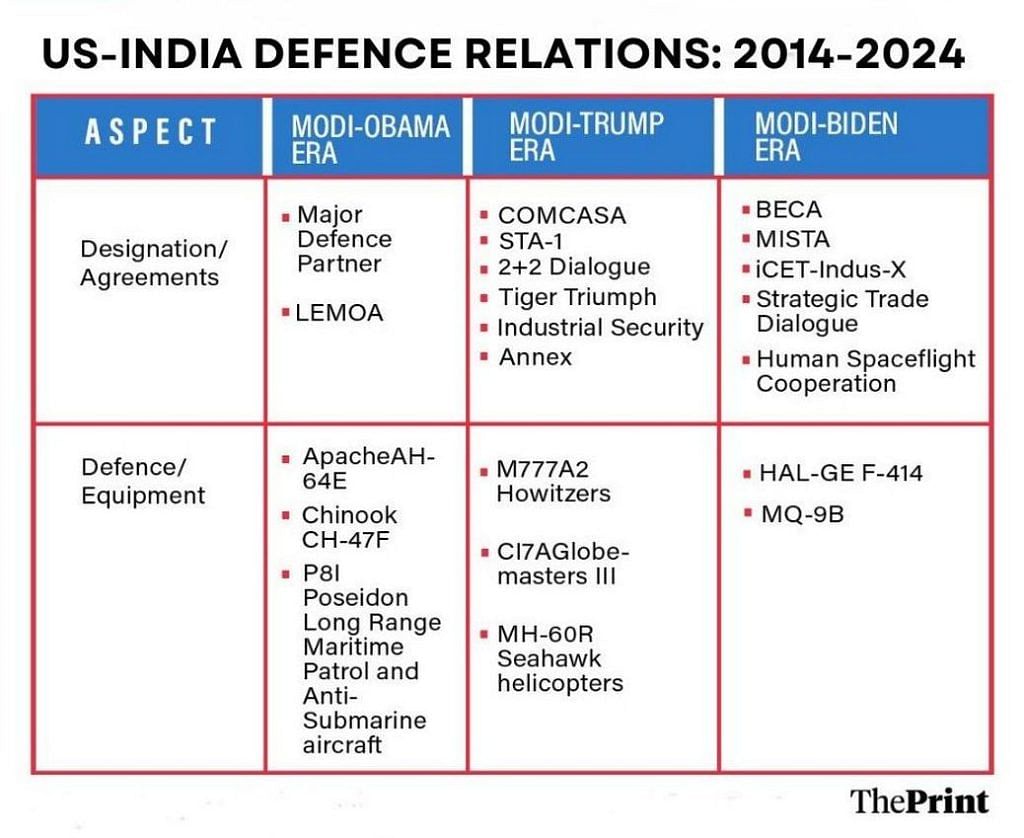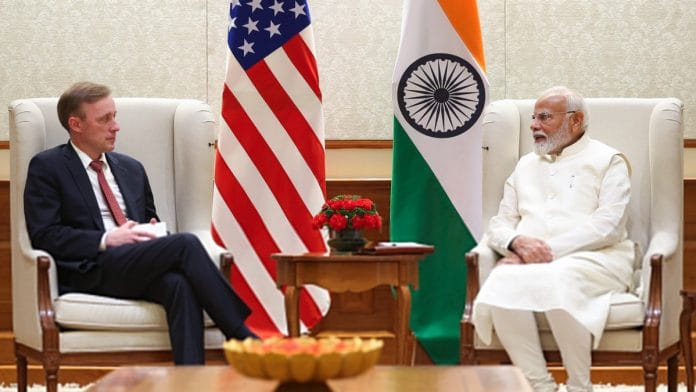When US National Security Advisor Jake Sullivan visited India on 17 June and called on Prime Minister Narendra Modi, it wasn’t just any diplomatic stopover. With Modi just starting his third term, the visit signalled the future potential of US-India defence cooperation.
Despite challenges, the relationship promises growth through enhanced public-private collaborations, regulatory reforms, and innovative defence technologies. With Modi 3.0 in India and new leadership incoming in the United States, now is the time to reflect on the relationship thus far and set strategic priorities for the future.
Milestones in the past decade
In 2016, the US designated India as a “Major Defense Partner”, laying the foundation for enhanced defence cooperation.
Over the next few years, India and the US signed three foundational agreements—the Logistics Exchange Memorandum of Agreement (LEMOA), the Communications Compatibility and Security Agreement (COMCASA), and the Basic Exchange and Cooperation Agreement (BECA)—which significantly bolstered their defence relationship.
Additionally, in 2018, India attained Strategic Trade Authorization Tier 1 (STA-1) status, allowing licence-free exports of specific controlled items from the US.

The two nations also launched their first maritime security dialogue, established the 2+2 Ministerial Dialogue, and reached key milestones like the first tri-service exercise “Tiger Triumph” and the signing of the Industrial Security Annex (ISA).
During Modi 2.0, the focus shifted to further strengthening India’s military capabilities.
Under the Initiative on Critical and Emerging Technology (iCET) framework, programmes like the India-US Defense Acceleration Ecosystem (INDUS-X) facilitated partnerships between Indian and American defence companies, investors, and universities. The Maritime Information Sharing Technical Arrangement (MISTA) also advanced intelligence cooperation.
To improve interoperability in space, the two countries devised a Strategic Framework for Human Spaceflight Cooperation, while the India-US Strategic Trade Dialogue (IUSTD) improved technology, trade, and export controls.
Major defence equipment deals, including discussions for MQ-9B Sky Guardian drones and co-production of F-414 fighter jet engines, brought the two countries’ defence procurement strategies into closer alignment. Naval cooperation also saw enhancement through agreements like the Master Ship Repair Agreement (MSRA) with Larsen and Toubro’s shipyard.
Another growing area of cooperation is artificial intelligence. In March 2021, the Indo-US Science and Technology Forum established the US-India Artificial Intelligence Initiative to focus on bilateral AI cooperation and research and development. Subsequently, plans were announced for launching the Defense Artificial Intelligence Dialogue and holding the second meeting of the US-India Advanced Domains Defense Dialogue.
What’s in store under Modi 3.0?
As India enters Modi 3.0, major strides are expected in US-India relations. While there are challenges to tackle, there is also room for much progress.
Upcoming initiatives & acquisitions
With the upcoming US elections, bipartisan support for US-India relations suggests that the strategic partnership will likely remain robust. India and the US are actively discussing the signing of the Security of Supply Arrangement (SOSA) and Reciprocal Defense Procurement Arrangement (RDP), which are both seen as pivotal for enabling Indian manufacturers’ access to the US market. Talks are also advancing for joint production of Stryker armoured combat vehicles.
Challenges
Complex regulatory environment: The regulatory landscape—governed by the International Traffic in Arms Regulations (ITAR), Export Administration Regulations (EAR), and the Arms Export Control Act (AECA)—presents substantial hurdles for US-India defence cooperation. These frameworks require stringent and resource-intensive licensing procedures. Despite improvements in ITAR processes, the underutilisation of STA-1 exemptions—used in less than 2 per cent of cases—raises questions about their effectiveness. This is largely due to the perception in India that the STA-1 provisions are both complex and time-consuming. Startups often struggle with India’s bureaucratic procurement process and complex acquisition system, turning to commercial markets instead. Streamlining this process to be more startup-friendly could encourage more defence applications.
Changing geopolitical dynamics: India’s longstanding defence ties with Russia cannot be easily dismissed. Despite India’s efforts to diversify its arms imports, this process is gradual. Penalising India for maintaining its defence relationship with Russia could undermine its military modernisation efforts and strategic autonomy. Meanwhile, US strategic engagements with Pakistan have caused concern in New Delhi. These factors further complicate perceptions and strategic alignments in US-India defence relations, particularly regarding interoperability and technology transfer.
Also Read: US senator introduces bill to enhance defence ties with India, calls it vital to counter China
Path for a resilient partnership
Public-private collaborations and capacity-building: Capacity-building should involve more private companies and universities in defence production, as seen in the partnership between IIT-Kanpur and Penn State. Efforts must be made to help startups secure significant procurement orders and ensure their products are rigorously tested to meet India’s defence requirements. Another proposal is for the Defense Innovation Unit (DIU) and Defense Advanced Research Projects Agency (DARPA) to set up incubator centres in major cities like Bengaluru, Hyderabad, Chennai, and Pune, hold promotional tours, and co-invest with Indian counterparts to address joint challenges.
Enhanced regulatory reforms: Efforts to address export controls and ease regulations are essential for enhancing defence collaboration. Further, the US and India, as leading digital start-up nations, should coordinate on shaping international AI digital governance for responsible defence innovation and application. This alignment could drive the development and governance of the digital economy in defence, benefiting both nations.
Encouragement for innovation: Under the INDUS-X initiative, efforts have been made to steer private capital toward budding startups. Such efforts should be encouraged to facilitate business and innovation. The first anniversary of INDUS-X on 21 June underscored its success in advancing US-India defence collaboration. Achievements include “joint challenges” on maritime ISR communications, the Gurukul Education Series, and academic partnerships. Establishing a joint innovation fund and accelerator programme can efficiently support startups. Enhancing talent mobility through fellowship programmes will also strengthen bilateral ties and industry capabilities.
The US-India defence partnership under Prime Minister Modi is now a cornerstone of bilateral relations. In Modi’s third term, and with bipartisan support for the US-India relationship in the United States, growth is anticipated in defence collaboration. The future looks promising, contingent on necessary reforms, sustained momentum, and opportunities for strategic dialogue, technological partnerships, and shared geopolitical goals.
Nikita Vardiparti is VP Operations at the IndUS Tech Council. Based in Boston, she is an international affairs analyst and a graduate of the Fletcher School at Tufts University.






